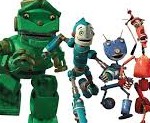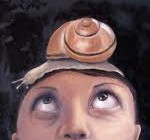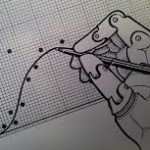Plenty of robots
It appears we can’t keep their pace. In a recent batch of news a friend found robots painting Van Gogh style, robots beating us on rock-paper-scissors (below, and btw that’s cheating on my playground), writing adventures and so on.
On the more troubling strain we try to make sure we control military robots, and wonder how great an idea is it to build system that deceive us, or how good an AI boss can be.
And while we can’t make ethical robots, and they are not yet out there firing (at) us, humans may enjoy treating robots like Yo-Yo Ma’s cello — as an instrument for human intelligence.
Recent evidence of Ape’s morals
Watching chimpanzees reactions to infanticide imagery bring evidence of Chimpanzee’s sense of right and wrong. Not far from what humans would deem relevant: From Claudia Rudolf et alli paper “Chimpanzees’ Bystander Reactions to Infanticide”
“we presented chimpanzees with videos depicting a putative norm violation: unfamiliar nonspecific engaging in infanticidal attacks on an infant chimpanzee. The chimpanzees looked far longer at infanticide scenes than at control videos showing nut cracking, hunting a colobus monkey, or displays and aggression among adult males. Furthermore, several alternative explanations for this looking pattern could be ruled out. However, infanticide scenes did not generally elicit higher arousal. We propose that chimpanzees as uninvolved bystanders may detect norm violations but may restrict emotional reactions to such situations to in-group contexts. We discuss the implications for the evolution of human morality.”
This latter behavior described is not unheard in humans, as Kitty Genovese murder case, when many bystanders failed to help to her as she was murdered and raped in two separate attacks. Not to mention mobs, lynching and other human habits.
Evidence at least as old as the bible is a reminder of how getting the sense of what is right is not enough – in case anyone say chimpanzee’s morals shouldering human’s is a clear upgrade.
“Atheism on Trial” by Stephen Anderson
From article by Stephen Anderson:
“There was a time – some years ago – when to profess disbelief in a Supreme Being could be hazardous to one’s health. (…). Today, atheism has taken its comfortable seat by the fire and has its feet up. (…). Atheism has never been so respectable.
That is why perhaps we now ought to pause and ask if it has actually earned the easy place it enjoys. (…) Before we begin the trial, perhaps we ought to clarify the case. What is ‘atheism’?
(…) It claims there exists no kind of god.
That’s basic. But we might ask, ‘Is it really necessary to understand atheism as so categorical? Can’t we make room for softer versions of skepticism, so as to be more inclusive?’
(…) But secondly, and more importantly, including agnostics in their position is going to give away the game at the start (…), it is a personal declaration of doubt, not a categorical one. In its strongest form, agnosticism says something like, “I really, really, really strongly don’t think there is any God, because I’ve seen no evidence anywhere near sufficient to make me think there is one.” But the savvy atheist is going to detect the problem: as a personal declaration, it fails to bind anyone else.Continue reading→
On unaccountable algorithms that watch and profile all
“Digital star chamber” featured on aeon magazine – by Frank Pasquale:
“The infancy of the internet is over. As online spaces mature, Facebook, Google, Apple, Amazon, and other powerful corporations are setting the rules that govern competition among journalists, writers, coders, and e-commerce firms. (…)
Algorithms are increasingly important because businesses rarely thought of as high tech (…) are collecting data from both workers and customers, using algorithmic tools to make decisions, to sort the desirable from the disposable.(…)
For wines or films, the stakes are not terribly high. But when algorithms start affecting critical opportunities for employment, career advancement, health, credit and education, they deserve more scrutiny. (…)Continue reading→
Mark my words
In “What Searchable Speech Will Do To You” , published in Nautilus, James Somers discuss some interesting aspects on the coming possibility of having all we say recorded. And then labeled, tagged, searched…
“We are going to start recording and automatically transcribing most of what we say. (…) It will happen by our standard combination of willing and allowing. It will happen because it can. It will happen sooner than we think.
(…) But would all of this help or hurt us? (…) The more we come to rely on a tool, the less we rely on our own brains.
(…) By offloading more of memory’s demands onto the Record (…) it might not be that we’re making space for other, more important thinking. We might just be depriving our brains of useful material. (…)
The worry, then, is twofold: If you stopped working out the part of your brain that recalls speech (…) your mind would become a less interesting place.Continue reading→
“A Gentle Guide to Machine Learning” by Raúl Garreta
Posted at MonkeyLearn
“Machine Learning is a subfield within Artificial Intelligence that builds algorithms that allow computers to learn to perform tasks from data instead of being explicitly programmed.
(…) some of the most common categories of practical Machine Learning applications:
Image Processing (…) : Image tagging (…) , Optical Character Recognition (…) , Self-driving cars (…)
Text Analysis(…) : Spam filtering, (…) Sentiment Analysis,(…) Information Extraction, (…)
Data Mining(…): Anomaly detection, (…) Grouping , (…), Predictions(…)
Video Games & RoboticsContinue reading→
can we keep walking? please…
When self-driving cars hit the streets, among other features it is expected that they take pedestrian safety seriously. This hope is illustrated by this couple of anecdotal stories show Google self driving car reactions to a lady chasing ducks on her wheelchair or a cyclist making a track stand.
But what next? After self-driving is supposedly stablished and approved technology, people will probably get back to the trend on posing pedestrian the blame. Ravi Mangla “The secret history of jaywalking: The disturbing reason it was outlawed — and why we should lift the ban” shows it happened in the past. Adoption of self-driving driving cars may be the opportunity window to have people free to walk again.
A similar claim comes from “The end of walking” by Antonia Malchik. When it comes to getting around, sitting apes have the high ground on the standing ones. It should also be noticed that such anti-pedestrian behaviour is growing among cyclists as well. Even if cyclists are in general much more civilized than car drivers. But so were drivers in automobile early days as well…
Computers outrunning our brain. What about choice?
About when people would seem enough to think of computing capacity in terms of FLOPS, supercomputers development makes the point that a better measure is TEPS. TEPS stand for Traversed edges per second, which is sort of FLOPS weighted by communication cost.
Anyway, fact is AI Impacts produced estimates for our Brain performance in TEPS. Next thing was the ubiquitous, of course. It would seem we can hire this computational power in the next decade by $ 100/hour. But for the time being this cost is estimated to be around $4,700 – $170,000/hour. So go to your boss and tell him he’s renting your brain for a bargain.
IF you do so, your odds are better if you skip the info below and make it simple. New studies show that our brains do consider cognitive effort when making choices. This ‘TLDR’ feature of brain wiring may be the culprit in preventing you to go through the paper “Separate and overlapping brain areas encode subjective value during delay and effort discounting” that says so.
Mathematics of an updated, plural Economics
Having similar applications, users, and backgound, at a distance Machine Learning may sometimes be confused with an application of Statistics.
A closer look reveal fundamental differences, as in “Why a Mathematician, Statistician, & Machine Learner Solve the Same Problem Differently” by Nir Kaldero.
One scientific field this difference comes to surface in a distinguished manner is economics, as Noah Smith’s “Economics Has a Math Problem” sensibly puts the emphasis on the way economics uses math.
Pushing science to new fields, scientists can now employ much more data and computational power than the time when a significant part of mainstream economics was developed. If econometric tools set the tone for neoclassic economic papers in the final decades of last century, could machine learning, Bayesian inference, and neural networks open new possibilities to economic theory?
One arguable example is “Mechanisms for Multi-unit Combinatorial Auctions with a Few Distinct Goods” by Piotr Krysta, Orestis Telelis, Carmine Ventre. Not a coincidence, researchers are not from Economics departments. Even if economists are stubborn enough to dismiss game theory as a non-fundamental field, message is clear: if economists don’t embrace new math, other scientists (human or not) could engulf economics less cerimoniously.
If this happens, will we find that Keynesian uncertainty and weight of arguments fits big data better than deterministic parameters of neoclassic mainstream?
Experimenting a proxy to Earth before life – in a toaster
From Nautilus, by Johnny Bontemps, The Dawn of Life in a $5 Toaster Oven:
“… A vintage General Electric model… for cooking up the chemical precursors of life, he thought. He bought it for $5.
At home in his basement, with the help of his college-age son, he cut a rectangular hole in the oven’s backside, through which an automated sliding table (recycled from an old document scanner) could move a tray of experiments in and out. He then attached a syringe pump to some inkjet printer parts, and rigged the system to periodically drip water onto the tray … in Hud’s laboratory at the Georgia Institute of Technology, where he directs the Center for Chemical Evolution, a multi-university consortium funded by NASA and the National Science Foundation. …
It simulates the cycles of cool and hot, and wet and dry, that Hud suspects jump-started this evolutionary process, millions of years before the first cellular life forms emerged…
Evolution requires two forces: variation and selection… Polymers can form, break down, and form again with new configurations. That’s variation. … They might fold into shapes that prevent them from breaking apart too quickly, for instance. That’s selection. …
The engine for life and evolution could then be, as Hud says, as simple as “a planet spinning in front of a star…” read full story









